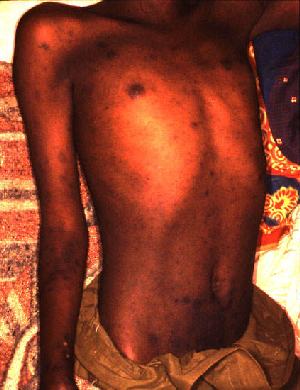Camp fever
| Typhus | |
|---|---|
| Synonyms | Typhus fever |
 |
|
| Rash caused by epidemic typhus | |
| Specialty | Infectious disease |
| Symptoms | Fever, headache, rash |
| Usual onset | 1–2 weeks after exposure |
| Causes | Bacterial infection spread by parasites |
| Treatment | Doxycycline |
| Frequency | Rare |
| Classification |
· ·
|
|---|---|
| External resources |
Typhus, also known as typhus fever, is a group of infectious diseases that include epidemic typhus, scrub typhus and murine typhus. Common symptoms include fever, headache, and a rash. Typically these begin one to two weeks after exposure.
They are caused by specific types of bacterial infection. Epidemic typhus is due to Rickettsia prowazekii spread by body lice, scrub typhus is due to Orientia tsutsugamushi spread by chiggers, and murine typhus is due to Rickettsia typhi spread by fleas.
There is no commercially available vaccine. Prevention is by reducing exposure to the organisms that spread the disease. Treatment is with the antibiotic doxycycline. Epidemic typhus generally occurs in outbreaks when poor sanitary conditions and crowding are present. While once common, it is now rare. Scrub typhus occurs in Southeast Asia, Japan, and northern Australia. Murine typhus occurs in tropical and subtropical areas of the world.
Typhus has been described since at least 1528. The name comes from the Greek typhus (τύφος) meaning hazy, describing the state of mind of those infected. While "typhoid" means "typhus-like", typhus and typhoid fever are distinct diseases caused by different types of bacteria.
The following signs and symptoms refer to epidemic typhus as it is the most important of the typhus group of diseases.
Signs and symptoms begin with sudden onset of fever, and other flu-like symptoms about one to two weeks after being infected. Five to nine days after the symptoms have started, a rash typically begins on the trunk and spreads to the extremities. This rash eventually spreads over most of the body, sparing the face, palms, and soles. Signs of meningoencephalitis begin with the rash and continue into the second or third weeks. Other signs of meningoencephalitis include sensitivity to light (photophobia), altered mental status (delirium), or coma. Untreated cases are often fatal.
...
Wikipedia
